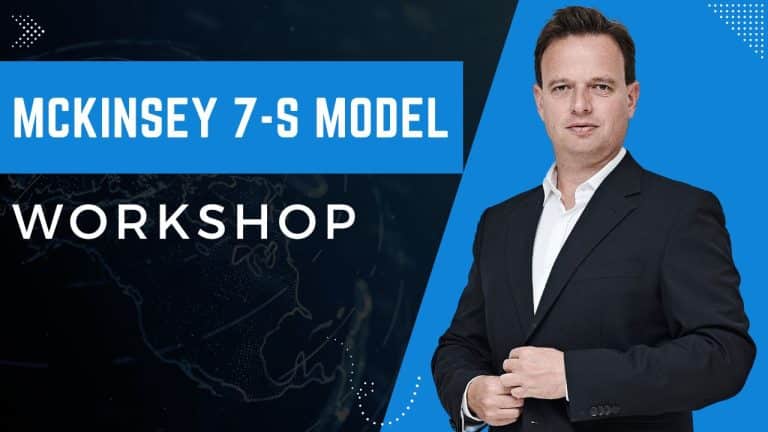Many teams struggle not because they lack talent or effort, but because the way they’re working together is out of sync.
In this article, I’ll share a simple team workshop using the McKinsey 7-S Model that helps uncover misalignment and turn it into progress.
It matters because performance suffers when strategy, structure, systems, and culture pull in different directions.
Clarity drops. Friction rises. People disengage.
Most teams don’t fail for lack of ideas—they fail because parts of their system aren’t aligned. And no one’s checking.
Here’s the truth:
High-performing teams don’t just work hard—they work in alignment. And alignment isn’t automatic. It needs to be designed and maintained.
What Participants Will Gain from This Workshop
By attending this workshop, participants will get:
- A clear view of how your team is performing across 7 key areas.
- Insight into what’s working—and what’s not.
- A shared language to talk about strategy, structure, and culture.
- Practical actions you can take right away to improve alignment.
- A boost in team clarity, connection, and ownership.
The McKinsey 7-S Model
The McKinsey 7-S Model is a practical way to look at how well the moving parts of your team are working together.
It breaks team performance down into seven areas:
- Strategy – where you're going and how you plan to get there
- Structure – how roles, teams, and reporting lines are set up
- Systems – the tools, processes, and routines that drive the work
- Shared Values – what your team believes in and stands for
- Style – how leadership shows up and sets the tone
- Staff – who’s on the team and how well they fit
- Skills – what the team is good at now and needs for the future
When these are aligned, teams move faster, communicate better, and make better decisions.
When they’re not, you get delays, confusion, and frustration.
A 90-minute workshop to build alignment
This workshop helps teams explore these seven elements in a structured, honest, and constructive way.
It’s designed to surface what’s going well, what needs attention, and what actions will make the biggest difference.
Here’s how it works.
Aligning Our Team with the 7-S Model
Objective: Help the team explore and align the seven elements of the McKinsey 7-S Model to strengthen collaboration and performance.
Duration: 90 minutes
Group Size: 4–12 people
Materials Needed
- Flipchart or whiteboard
- Sticky notes in 3 colours
- 7 printed posters or headings: one for each “S”
- Markers
- Timer
Workshop Plan
- Start with the why (10 minutes)
- Silent Reflection (15 minutes)
- Group Gallery Walk (15 minutes)
- Open Discussion (35 minutes)
- Agree Actions (15 minutes)
Step 1: Start with the why (10 minutes)
Introduce the idea:
“High-performing teams don’t just work hard—they work in alignment. This session will help us look at how well we’re set up to succeed, using a simple but powerful model.”
Briefly explain the 7-S Model in plain language (see earlier section). Keep it simple.
Then share the goals of the session:
- Reflect on how we’re doing across the 7 elements
- Spot strengths and areas of misalignment
- Agree on a few clear actions to improve team performance
Step 2: Silent Reflection (15 minutes)
Give each person 7 sticky notes or prompts (one for each “S”). Ask them to reflect silently:
“How well is this element working in our team right now?”
Use a traffic light system:
- Green = Strong
- Yellow = Needs attention
- Red = Misaligned or unclear
One note per element. Encourage short, specific notes.
Step 3: Group Gallery Walk (15 minutes)
Set up 7 flipchart sheets or headings around the room (or use shared digital boards).
Participants place their notes under each heading. Everyone walks around and reads what others have written. No discussion yet—just absorb the patterns.
Step 4: Open Discussion (35 minutes)
As a group, go through each of the seven elements. Focus more time on areas with the most yellow and red notes.
Use questions like:
- What do we notice?
- Where are we clear—and where are we not?
- What’s getting in the way of alignment?
- What’s already working well?
- What could be better?
- What more could we do?
Capture key insights on a shared board or flipchart.
Step 5: Agree Actions (15 minutes)
For each “S” (or the top 2–3 priorities), ask:
- “What’s one action we could take to improve this area?”
- “What would make the biggest difference?”
Write down each action clearly. Assign ownership if appropriate.
Key outcomes
By the end of the session, the team will have:
- A shared understanding of where they stand.
- Increased clarity around roles, direction, and values.
- A few targeted actions to increase alignment and performance.
Final thoughts
You don’t need a big restructure or a new strategy to improve team performance.
Often, the biggest gains come from simply stepping back and asking: Are we really aligned?
This workshop gives your team the space to reflect, talk honestly, and take ownership of what needs to change.
It builds clarity. It surfaces what matters. And it creates momentum.
Because when people understand how their work fits together—and feel part of shaping it—they don’t just perform better.
They show up stronger every day.
See you next week.

